

A Plot on a Plate: When Food is the Secret Star of a Film
Plating up the universal language of food, inspiring us to cook, eat, and explore like never before.
In cinema, food often transcends its role as mere sustenance to become a central character, weaving through narratives with the power to evoke nostalgia, convey emotion, and bring people together. From the bustling streets of Mumbai in The Lunchbox to the charming French countryside in Julie & Julia, food serves as a universal language, communicating love, loss, joy, and discovery.
But why does food hold such a revered place in storytelling? At its core, food is deeply personal yet universally relatable, capable of telling stories about culture, tradition, and personal identity. It’s a sensory experience that connects us to memories and emotions, making it a powerful tool for filmmakers to engage audiences and enrich their cinematic journeys.
Breaking Down Barriers with Every Bite
Cinema has a unique way of taking us on a trip into the heart of kitchens and dining scenes that are very different from our experiences but highly familiar. It’s like tasting something entirely new without leaving your home. Imagine a Punjabi getting a peek into the making of a Kerala Sadya with The Great Indian Kitchen or someone from Odisha getting their first virtual taste of Delhi’s street food in Dilli 6. It’s all about connecting dots between cultures, making us realize how diverse yet similar we are, all through the universal love for food.
Keeping Traditions Alive
Movies are more than just entertainment; they’re keepers of tradition, capturing the essence of recipes and cooking styles that might have been lost in time. When a film zooms in on the preparation of regional specialties, it’s like creating a time capsule for Indian culinary art, one that’s passed from one generation to the next. It’s a celebration of our diverse food heritage, from the unique South spices to the rich North flavours, keeping the story of Indian cuisine alive and kicking.
Sparking Culinary Curiosity
Have you ever seen a dish on screen and felt the urge to make it yourself? That’s cinema stirring up the chef in you, inviting you to explore and expand your food repertoire. But it’s not just about following a recipe; it’s about embracing the whole dining culture — how we eat, present our food, and what each dish means to its people.
Feeding the Wanderlust
And then, there’s the way food in movies can make us want to pack our bags and go on a food hunt. Watching the authentic preparation of local delicacies turns us into culinary tourists eager to experience these flavours at the source. This kind of film-inspired tourism doesn’t just put places on the map; it deepens our travel experiences, making us part of a place’s living, breathing culture. It’s about tasting the soul of a place, one bite at a time.
Here’s a tour through seven iconic dishes featured in Indian movies that have captured our imaginations and appetites.
1. The Great Indian Kitchen
It is a profound Malayalam film that delves into the life of a newlywed woman as she finds herself confined within marriage and the domestic expectations that come with it. Beyond its portrayal of the daily grind and the often underappreciated labour within the confines of the kitchen, the film masterfully highlights the preparation of a traditional Kerala Sadya.
This elaborate vegetarian feast, elegantly served on a banana leaf, includes a variety of dishes such as sambar, avial, and payasam, symbolizing not just the rich tapestry of Kerala’s culinary traditions but also mirroring the complexity and richness of women’s roles in society. Through its sensory journey into Kerala’s culinary heritage, the film intertwines the celebration of flavours with a potent narrative on women’s empowerment and the quest for equality, reminding us of the deep-seated gender roles that permeate even the most intimate spaces of our lives.
2. Piku
A heartwarming Hindi film, it intricately explores the dynamics of a Bengali family through the lens of their shared meals, embedding the essence of soulful Bengali cuisine into its narrative. As the film unfolds, scenes laden with the preparation and enjoyment of traditional dishes such as fish curries, dal, fried vegetables, and the sweet delicacy sandesh do more than showcase the culinary culture; they serve as a metaphor for the complexity and richness of family bonds and heritage.
Each meticulously prepared and savoured meal becomes a medium for expressing love, care, and the unspoken intricacies of the father-daughter relationship at the heart of the story. Through the depiction of these culinary moments, Piku invites viewers to appreciate the art of Bengali cooking and understand how food can be a powerful conduit for conveying deeper emotional narratives and connections within a family.
3. Dilli 6
Set against the backdrop of Old Delhi, Dilli 6 is more than just a cinematic exploration; it’s a confluence of diverse cultures and religions through the city’s rich street food culture. As the narrative unfolds amidst the bustling lanes of Chandni Chowk, the film artfully uses the allure of chaats, the sweetness of jalebis, and the smoky flavours of kebabs as symbols of Delhi’s rich heritage.
Each dish is a testament to the city’s ability to blend traditions, tastes, and communities. By showcasing these iconic flavors, Dilli 6 invites viewers to experience the unity in diversity emblematic of Delhi, where food becomes the medium through which cultures and religions come together.
4. Jigarthanda
A captivating Tamil film that unfolds in the bustling city of Madurai and is named after the city’s beloved drink, Jigarthanda. This refreshing summer beverage, a blend of milk, almond gum, sarsaparilla syrup, and ice cream, is more than just a treat to cool off from the heat; it’s a cultural emblem of Madurai. The film cleverly integrates this local favorite into its storyline, making the drink a symbol of Madurai’s rich culinary landscape and its ability to bring people together.
Through its title and narrative, Jigarthanda invites viewers into the heart of Madurai, offering a taste of the city’s vibrant street food culture. With its unique ingredients and cooling effect, the drink itself mirrors the film’s exploration of diverse themes and the blending of different elements to create something extraordinary. By centering around Jigarthanda, the film celebrates a local delicacy. It highlights the communal joy of sharing a beloved beverage, making it a poignant reminder of the shared experiences that define a place and its people.
5. Ustad Hotel
This heartwarming Malayalam film tells the story of a young man who, contrary to his father’s wishes, navigates his path to becoming a chef. Central to this tale is the Malabar biryani, a delicacy from Kerala’s coastal regions distinguished by its aromatic flavors and the special small-grained Khaima or Jeerakasala rice. This biryani isn’t just presented as a culinary highlight; it becomes a metaphor for the protagonist’s journey in the culinary world.
In the film, the Malabar biryani symbolizes the protagonist’s connection to his heritage and his innovative spirit as a chef. It illustrates his journey of blending tradition with his ambition, mirroring the layers of flavors in the biryani itself. The dish represents the challenges he faces and overcomes, the blend of old and new, and ultimately, his success in finding his unique voice in the vast world of gastronomy. Through Ustad Hotel, the Malabar Biryani is transformed from a mere recipe into a narrative device that enriches the protagonist’s quest to fulfill his culinary dreams.
6. Vanakkam Chennai
In Vanakkam Chennai, a Tamil film that weaves a tale of love, connection, and discovery, the humble yet profoundly comforting dish of idli and sambhar is a poignant symbol. Its presence in the film does more than highlight the region’s everyday cuisine; it deeply intertwines with the narrative, reflecting the film’s themes of simplicity, belonging, and the emotional resonance of home-cooked meals.
As viewers journey through the storyline, including idli and sambhar, subtly mirrors the characters’ experiences of finding comfort and familiarity in new surroundings. This dish, emblematic of home for many in Tamil Nadu, becomes a metaphor for the characters’ search for identity and connection in the bustling urban landscape of Chennai. Through this culinary reference, Vanakkam Chennai beautifully encapsulates that the most unassuming aspects of our lives, like a simple meal, can hold the most significant emotional value, offering solace and a sense of home amidst life’s complexities.
Food transcends its role as mere sustenance to become a storyteller in its own right. These narratives, steeped in the flavours and traditions of their respective cultures, reveal how food connects us—to our heritage, to each other, and to the stories that weave the fabric of our lives. Through the preparation, sharing, and enjoyment of meals, films across genres and geographies invite us into a shared human experience, where every dish tells a story of identity, community, and the universal search for belonging.
We’re reminded of its power to nourish the body and feed the soul, sparking conversations that delve into the depths of societal norms, personal aspirations, and the bonds that tie us together. Ultimately, these cinematic feasts offer more than just a visual and sensory delight; they serve as a testament to the enduring magic of food as a symbol of love, memory, and the simple joys that flavor our existence. So, as we move forward, let’s carry with us the lessons and inspirations drawn from these stories, allowing them to enrich our palate and our understanding of the world and our place within it.






